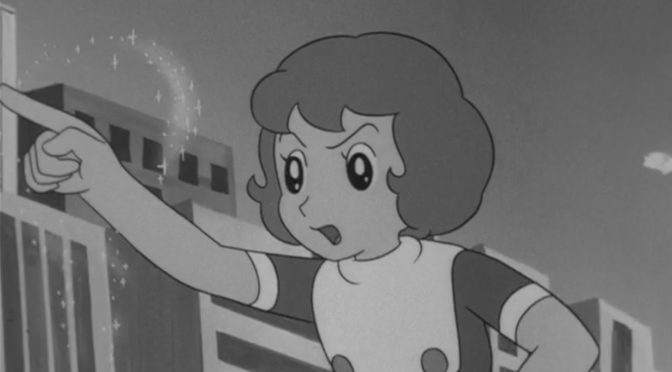
by Janice L. Newman
We visited Japan earlier this summer, and had a lovely time. It’s always interesting comparing how life is different in Japan from our Southern California home, whether it be fish and rice for breakfast or the excellent train system that got us around Tokyo quickly and easily.
Our hotel room had a television, and since we craved immersion whether inside the hotel or out, we often have the boob tube on. Sadly, Japan has a "vast wasteland", too. Between the sumo bouts, the soap operas, the game shows, and the period dramas, there wasn't much of interest to us, although the fact that everything was in Japanese was a plus.

However, we found that if we tuned in at the right time of the day, there was gold to be found. Indeed, we found them in the surprising form of a couple of children’s cartoon shows. They both echoed Western shows in familiar ways, yet also had elements we’d never seen before.
A Magical Girl

The first show was “Mahoutsukai Sally”, or “Sally the Witch”. This charmingly silly show is about a little girl who is the princess of a ‘magical kingdom’. She comes to earth and makes friends here, hiding her magical abilities, which apparently allow her to do almost anything. Most of the time she uses her magic to stop ‘bad’ people; burglars, kidnappers, bullies, and the like.
Stylistically, Sally reminds me of Disney’s early cartoons, the old black and white ones with Mickey Mouse. There’s a strong slapstick element, and the episode plots aren’t particularly concerned with things like consistency or the laws of physics.

On the other hand, the story, with its focus on Sally and her friends, is unusual. Most of the cartoons I’ve seen on American TV have had main characters who are boys. There are superhero shows and adventure shows, like The Amazing Spiderman, The Fantastic Four, Superman, and Johnny Quest. There’s no reason a girl can’t watch superhero shows, of course, but “Mahoutsukai Sally” not only stars a little girl, it focuses on everyday elements of her life in ways that are unusual in American television. For example, she makes new friends at school, invites them over, and secretly magics up a cake for them to share. There’s plenty of drama and adventure, but there are also moments of domesticity, like Sally helping her friend babysit her little brothers. Though infused with ridiculous and sometimes nonsensical plot twists, making the story about a little girl’s life and giving that little girl power makes this cartoon something special. Sure, we’ve had a few cartoons with a girl in the lead, like the Little Audrey shorts, but children’s TV in the USA these days is much more likely to give you a show with a powerful boy (or a man, or a group of men) as the main characters. Sally is a breath of fresh air.

On the third hand, Sally does resemble a different kind of American TV show: recent sitcoms! There’s been a trend in American TV over the past few years toward ‘spooky’ or supernatural family shows like The Munsters, The Addams Family, and especially Bewitched. Sally strongly resembles the last of these, but fashioned for small children instead of adults, with a little girl witch instead of a grown woman. In fact, word has it that the original Mahoutsukai Sally comic was inspired by Bewitched!
A Magical…Boy?

This one, we discovered both the television show and the "manga" (comic) at the same time. GeGeGe no Kitaro, though no less charming than Sally, is perhaps a bit more alien. It is a story focusing on a Japanese youkai. “Youkai” is a difficult word to translate because it’s used as a bit of a catchall for supernatural beings like ghosts, demons, and other sorts of mysterious spirits. “GeGeGe” is an onomatopoeic word that sounds like cackling, or perhaps a ghostly giggle. Kitaro, the hero, is not a scary youkai, though. He’s a kind and helpful lad who uses his powers to fight bad Eastern youkai, evil Western youkai (like Dracula and the wicked witch) and even giant Godzilla-like monsters!

Kitaro is fascinating to watch because it’s a deeply Japanese show. The closest analog would be Casper the Friendly Ghost, which also has a little boy ghost who helps people. But Kitaro’s roots in Japanese folklore and the villages he helps protect offer Americans a glimpse into what life is like in Japan today: older villages existing alongside slick new cities, just as people still walk around in kimono and yukata almost as often as people wear western suits and dresses. Kitaro himself is a product of an old and new world: an old folktale brought to new life on the television screen.

It's also tremendously funny, and extremely good-natured, though the themes can be heavy for a children's show. Indeed, in the aforementioned battle between Eastern and Western horrors, there are a number of deaths (though, technically, the youkai are already kind of dead, as is Dracula…) This heaviness, and the deeply regional nature of the show means that American companies will not likely scramble to re-dub it for American audiences. Sally might fare better, but it, too, seems to have been neglected.

Oh well. At least we got Astro Boy and Kimba the White Lion! And thanks to our knowledge of Japanese, we can look forward to our next trip across the Pacific, not just to visit our friends, but to see what new children’s shows Japan will come out with!


